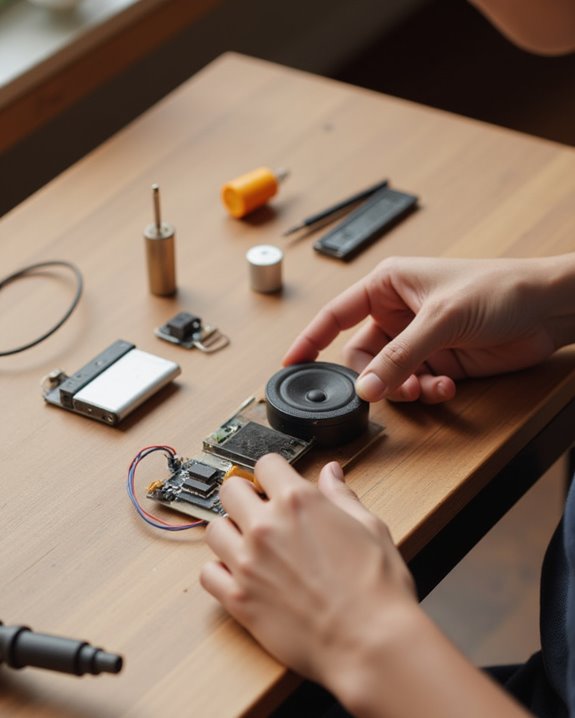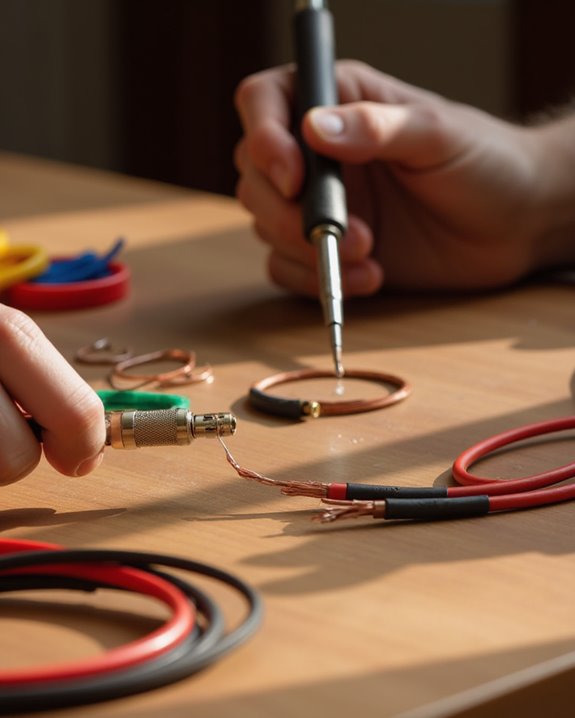For surround sound systems, 16 AWG speaker cable works well for runs under 50 feet with 8-ohm speakers, while 14 or 12 AWG is recommended for longer distances or 4-ohm speakers. Budget options like Mediabridge provide good value, while premium brands such as AudioQuest Rocket or Chord Company RumourX offer enhanced clarity for discerning listeners. Cable quality impacts signal integrity across all channels, affecting overall system performance. The right cable choice depends on specific room configurations and speaker impedance requirements.
Key Takeaways
- For standard 8-ohm surround speakers under 50 feet, 16 AWG cable provides sufficient conductivity while remaining cost-effective.
- Lower impedance 4-ohm speakers require thicker 12-14 AWG wire, especially for runs exceeding 25 feet.
- Budget-friendly options include Mediabridge cables for basic setups or Chord Company C-Screen with oxygen-free copper for modest systems.
- Premium cables like AudioQuest Rocket 22 or QED Golden Anniversary XT offer superior clarity for audiophile-grade surround systems.
- Most “audiophile” cable claims are exaggerated—standard oxygen-free copper performs comparably to exotic alternatives in typical home theater setups.
Wire Gauge Requirements for Different Speaker Distances
The proper selection of speaker wire gauge is critical for maintaining ideal audio performance in any surround sound system, with distance serving as the primary determining factor. For standard 8-ohm rear speakers positioned less than 50 feet from the receiver, 16 AWG speaker wire provides sufficient conductivity while remaining cost-effective. However, when distances exceed this threshold, upgrading to 14 or 12 AWG becomes necessary to prevent signal degradation.
Low-impedance speakers (4 ohms) demand more attention to wire gauge selection, as their critical distance limit for 16 AWG wire reduces to just 25 feet. In these setups, thicker 14 or 12 AWG wire becomes essential for maintaining frequency response within acceptable parameters. Empirical testing confirms that 12 AWG wire minimizes frequency response variations to within -0.5 dB, especially important for systems with extended cable runs.
Speaker Impedance and Its Impact on Cable Selection
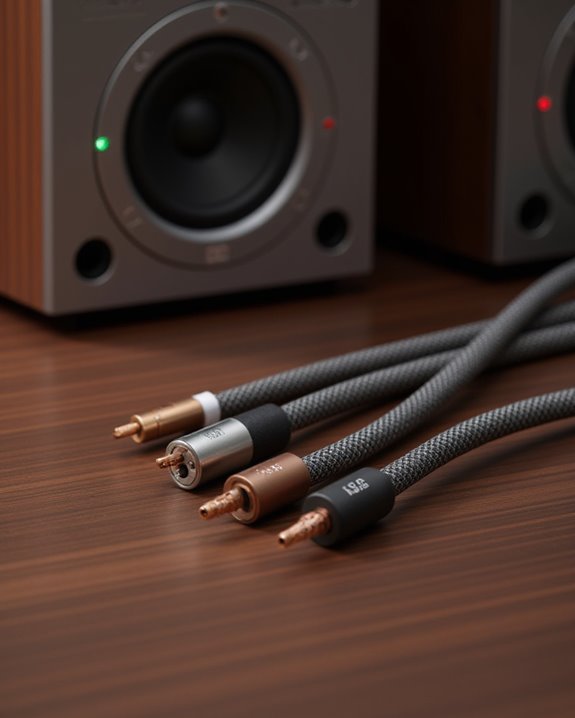
Understanding speaker impedance is fundamental when selecting appropriate cables for surround sound systems, as this electrical characteristic directly influences how much current flows through your audio setup. Lower impedance speakers, particularly 4-ohm models, demand thicker speaker wires such as 12 or 14 AWG to maintain signal integrity, especially for longer cable runs. When working with these lower impedance systems, the critical distance for ideal performance is effectively halved compared to standard 8-ohm speakers.
Speaker cables for 8-ohm configurations can adequately utilize 16 AWG for distances under 50 feet, while 4 or 6-ohm speakers require lower gauge numbers to prevent frequency response variations beyond -0.5 dB. This relationship between impedance and cable thickness is particularly essential in high-power applications, where voltage drop across thinner wires can substantially compromise audio fidelity.
Budget-Friendly Cable Options That Deliver Quality Sound

Building a surround sound system with quality cables doesn’t necessarily require breaking the bank, especially once appropriate impedance requirements have been determined. Several manufacturers offer cost-effective speaker cable options that maintain respectable sound quality while remaining budget-conscious.
The Chord Company provides two excellent choices: the C-Screen, featuring twisted-pair construction with oxygen-free copper conductors, ideal for modest systems; and the RumourX, which utilizes silver-plated copper conductors for neutral sound and rhythmic drive at approximately £45-£49. AudioQuest Rocket 11, priced between £12.95-£17.95, delivers transparency through long-grain copper construction, making it suitable for runs under 50 feet. For simpler setups, standard 16 AWG stranded copper wire serves as a practical solution for rear surround speakers, particularly with 8 ohm systems over short distances. Mediabridge cables represent another reliable alternative that balances performance with affordability in surround sound applications.
Premium Cable Brands Worth the Investment
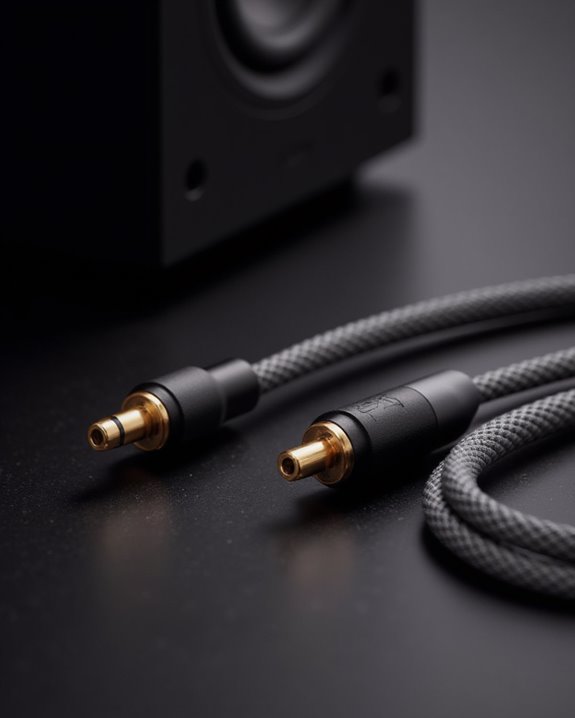
For audiophiles seeking to maximize their surround sound experience, premium speaker cables represent more than just an indulgence—they deliver measurable performance improvements that justify their higher price points. The AudioQuest Rocket 22, a particular brand featuring double low-inductance twisted construction with semi-solid true-concentric copper, provides refined sound and authoritative presentation for advanced surround systems.
Similarly, the Chord Company RumourX employs silver-plated Oxygen-Free Copper conductors in a 6mm twisted pair design, delivering clearer, more transparent sound with tauter bass performance. For those prioritizing analytical sound, QED Golden Anniversary XT offers superior clarity and detail precision compared to alternatives. Investment in these premium options, available from £17.95 at AV.com to £489 at Richer Sounds, guarantees minimal signal degradation and enhanced rhythmic drive that complements high-end surround system investments.
Common Cable Myths and Misconceptions Debunked
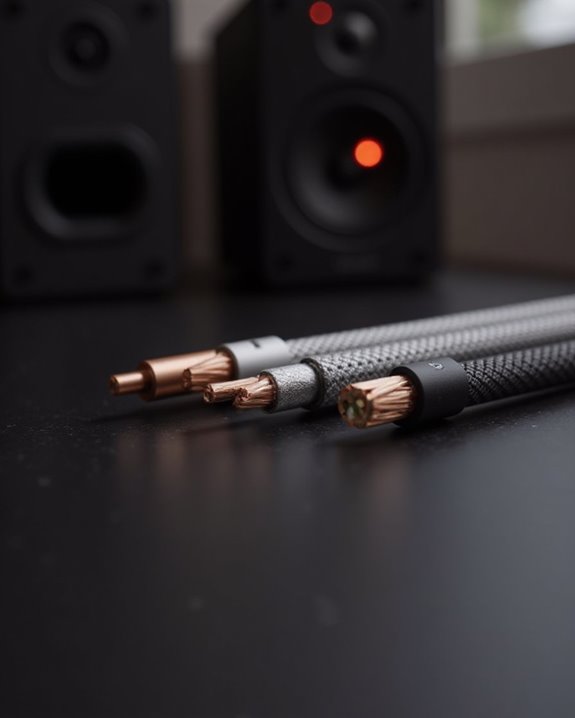
When exploring the world of surround sound cables, enthusiasts often encounter a labyrinth of marketing claims and audiophile folklore that can lead to unnecessary spending and unrealistic expectations. Despite persistent myths, standard oxygen-free copper conductors like those in the Chord Company C-Screen deliver performance comparable to exotic, pricier alternatives in typical surround setups.
Many consumers mistakenly believe thicker cables always produce better sound, yet 16 AWG wire sufficiently handles most home theater configurations with distances under 50 feet. Similarly, the notion that all surround sound cables require shielding proves unnecessary, as unshielded options like Belden 8477 perform reliably in standard installations. Package-included cables, such as those accompanying Yamaha NS-SP1800 systems, often provide adequate performance despite marketing suggesting otherwise. Consumers should verify specifications rather than trusting misleading gauge claims that frequently appear on marketplace listings.
However, with the rise of wireless surround systems that offer ranges up to 30 meters, the emphasis on cable quality may be less critical in modern setups relying on Bluetooth and other wireless connections.
Practical Tips for Installing Surround Sound Cables

After understanding the difference between marketing claims and actual performance requirements, homeowners can focus on proper installation techniques that truly impact audio quality. When routing audio cables, use 18-gauge wire for tight spaces where flexibility matters, while choosing 16 AWG for runs up to 50 feet with 8-ohm speakers. For longer installations extending to 100 feet, choose the right CL2-rated cables, such as C&E Series, to guarantee fire safety compliance in wall cavities. Before final installation, verify the actual gauge of purchased cables through physical measurements, as marketplace descriptions can be misleading. Position all surround sound wiring away from power lines and potential interference sources, maintaining separation that preserves signal integrity throughout the installation, especially when setting up complete systems like the Yamaha NS-SP1800 5.1 configuration. Moreover, for setups aiming for immersive audio, integrating options like virtual surround sound can enhance the overall experience by providing advanced sound processing without extensive wiring.
Cable Management Solutions for Clean Home Theater Setups
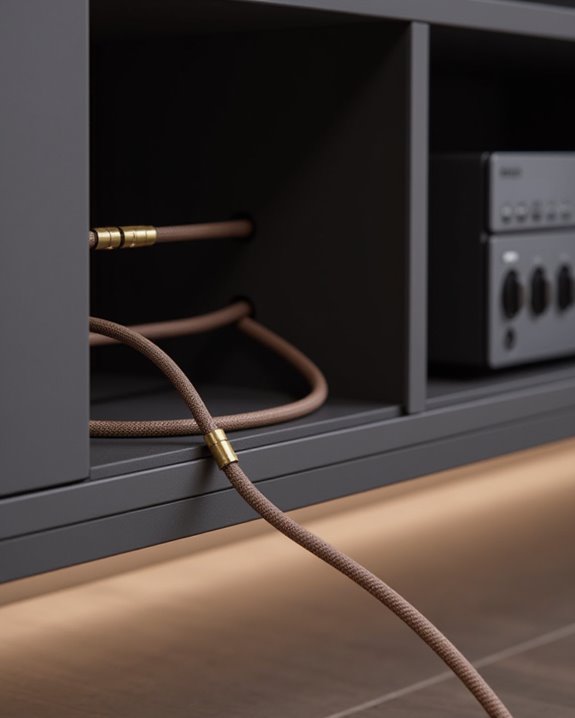
The unsightly tangle of cables behind a home theater system can detract from even the most sophisticated audio setup, making effective cable management essential for both aesthetics and functionality. Selecting properly rated cables, such as CL2-rated C&E Series 12 Gauge AWG for longer runs or flexible 16 AWG stranded copper wires for distances under 50 feet, provides the foundation for organized installations.
For the right speaker and other components positioned closer to the receiver, limiting cable lengths to 1-3 meters minimizes excess wire accumulation. Quality connectors like banana plugs facilitate clean connections while enabling easier system reconfiguration. When sourcing materials from reputable manufacturers such as Mediabridge, installers can confidently bundle and route cables according to gauge requirements—upgrading to thicker 12 or 14 AWG for extended runs to maintain signal integrity and visual orderliness.
Additionally, to minimize cable needs in modern setups, integrating wireless surround systems can greatly simplify your home theater configuration.
Frequently Asked Questions
Which Is Better, 16 Gauge or 14 Gauge Speaker Wire?
14 gauge wire offers superior performance for longer runs and low-impedance speakers. While thicker, it maintains signal integrity better than 16 gauge. Flexibility comparison shows 16 gauge easier for installation tips involving tight spaces.
Which Is Better, 18 Gauge or 12 Gauge Speaker Wire?
Gauge selection depends on specific needs. 12 gauge provides superior power efficiency for longer runs and low-impedance speakers. 18 gauge suffices for short distances, but 12 gauge delivers more reliable performance in demanding audio setups.
What Cable Gives the Best Sound Quality?
The Chord Company RumourX offers superior sound quality through premium material types like silver-coated copper strands and high-end connector quality with ChordAlloy plugs, delivering clearer, more transparent audio with refined bass and treble performance.
Do I Need CL2 or CL3 Speaker Wire?
Like a shield protecting precious treasures, residential installations typically require CL2 speaker wire. CL3 is necessary for higher power demands or when local building codes mandate stricter Fire Ratings for Safety Compliance.


